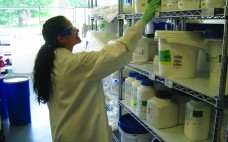T-cell therapy is a rapidly growing field of personalized medicine, attracting the interest of venture capitalists and pharmaceutical companies alike. Such therapies exploit T cells’ innate abilities to protect against pathogens as well as to seek and destroy cancerous cells. Although many different forms of T-cell therapies are currently in clinical trials, they all follow a common protocol: T cells are isolated from a patient, modified and expanded in a laboratory setting, and then infused back into the same patient…
Manufacturing
Bioreactor Design for Adherent Cell Culture — The Bolt-On Bioreactor Project, Part 1: Volumetric Productivity
The Bolt-on Bioreactor (BoB) project is an independent initiative aimed at developing and commercializing a bioreactor for efficient, automated culture of adherent cells in production of therapeutic cells and other biopharmaceuticals (1). After conducting thorough research on available culture systems for adherent cells, the BoB team believes that a successful alternative to existing devices must solve four major challenges. The first challenge has to do with volumetric productivity, the second with process automation, the third with containment and sterility, and…
Evaluating Freeze–Thaw Processes in Biopharmaceutical Development – Small-Scale Study Designs
Regulations mandate that biopharmaceutical product quality be controlled throughout manufacturing, storage, transportation, and delivery to patients (1). Operations often include freezing and thawing of a bulk drug substance, dilution of that purified substance to a target concentration, filtration, filling into a selected container–closure system, additional processing (e.g., lyophilization), inspection, packaging, storage, transport, and delivery (2). Freezing is a common processing step used to maintain stability and quality of a drug substance during development and production of biopharmaceutical products. It is…
Recruiting and Market Share Reshape Life Sciences Facilities and Locations
Where a biopharmaceutical company does business affects its profitability — as does how it manages its facilities and even where its non–customer-facing operations are located. In fact, facilities and real estate represent some of the biggest expenses for such companies. And yet, they are often overlooked. In today’s shifting global life-sciences landscape, site selection and management strategies are coming to the forefront as companies seek operating efficiencies, access to multidisciplinary talent, and cost-effective facilities. The following insights from JLL’s 2014…
Modern Laboratory Design: Creating a Space for Effective Collaboration
When asked to envision a modern biotechnology laboratory, lay persons might describe what they’ve seen on an episode of CSI: Miami. Gleaming glass and striking colored lights might look good on television, but they are not what biological researchers need to do their work most effectively. Most of the real biological laboratories I’ve visited, in fact, have been stark, white, fluorescent-lit environments that more resemble something out of 2001: A Space Odyssey. But those are becoming passĂ©. The newest concepts…
Exploring Options for Dual Sourcing of Single-Use Components
As the bioprocess industry progressively adopts single-use technologies for large-scale manufacturing (1, 2), biomanufacturers’ increased reliance on integrators for critical production equipment continues to raise concerns about supply chain security. The need to mitigate risks associated with the supply of single-use components (e.g., bioreactors, aseptic connectors, tubing, filters) has led to growing interest in the dual sourcing of those materials. To that end, integrators and end users alike are exploring the definition of functionally equivalent products, how functional equivalency can…
The US Biosimilars Future Is Hard to Predict: Global Health Policy, Innovation, Prices, and Profits Are All at Stake
Enthusiasm in the United States over opportunities for biosimilars has waned since such products were first launched in Europe. The hesitation stems from confusion and uncertainty surrounding regulations. Manufacturers and suppliers are looking for guidance from the US Food and Drug Administration (FDA), which has promised guidelines that are still in process after five years. Even naming protocols for biosimilars are clogging the works. And in the absence of coherent FDA guidelines, many US states are haphazardly implementing laws concerning…
Build, Buy . . . or “Rent” Capacity? A New GMP Biomanufacturing Business Model
When it’s time to move from preclinical to clinical-phase product testing, many biopharmaceutical companies face a difficult decision: whether to build or buy a biomanufacturing facility for in-house production or outsource the work to a contract manufacturing organization (CMO). Accinov is a new company that straddles the line between those concepts. Its new biomanufacturing center supports client companies toward clinical development in an innovative way. We propose a groundbreaking model for running good manufacturing practice (GMP) biomanufacturing. Our company’s approach…
Shrink Your Inventory Costs And Make Your Staff Happier
Shire’s process development department recently overhauled its inventory control system. The result was a projected five-year net benefit of over US$1.5 million and an immediate increase in its scientists’ productivity and satisfaction. Hiding in Plain Sight We asked one of our scientists why he kept 12 cases of gloves on his laboratory bench. “I use a lot of them,” he told us. “I don’t want to run out.” When asked how long his supply would last, he replied, “I don’t know.…
Guidance Is Lacking in the European Biosimilar Regulatory Framework: Considering the Dynamic of Quality Profiles in Development
Biopharmaceutical medicinal products (biologics) had an estimated global commercial market size of US$100 billion in 2013. Because they are more complex than small molecules — and defined by the uniqueness of their manufacturing processes — the generics approval process is not applicable for biologics. Article 10(4) of European Medicines Agency (EMA) directive 2001/83/EC was amended in 2004 in response to the industry’s desire for market access by launching a “similar” biologic abbreviated approval pathway. Leading the subsequent process, the EMA…









